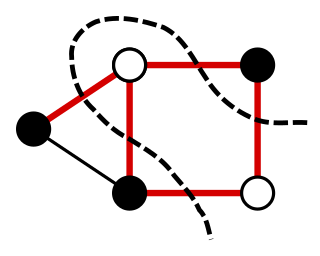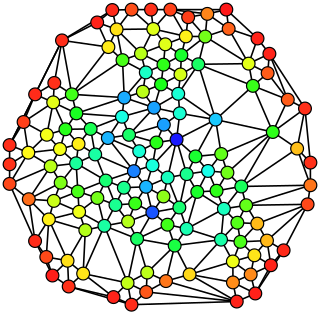
In mathematics, a hypergraph is a generalization of a graph in which an edge can join any number of vertices. In contrast, in an ordinary graph, an edge connects exactly two vertices.
This is a glossary of graph theory. Graph theory is the study of graphs, systems of nodes or vertices connected in pairs by lines or edges.

In mathematics, random graph is the general term to refer to probability distributions over graphs. Random graphs may be described simply by a probability distribution, or by a random process which generates them. The theory of random graphs lies at the intersection between graph theory and probability theory. From a mathematical perspective, random graphs are used to answer questions about the properties of typical graphs. Its practical applications are found in all areas in which complex networks need to be modeled – many random graph models are thus known, mirroring the diverse types of complex networks encountered in different areas. In a mathematical context, random graph refers almost exclusively to the Erdős–Rényi random graph model. In other contexts, any graph model may be referred to as a random graph.
In the mathematical field of graph theory, the Laplacian matrix, also called the graph Laplacian, admittance matrix, Kirchhoff matrix or discrete Laplacian, is a matrix representation of a graph. Named after Pierre-Simon Laplace, the graph Laplacian matrix can be viewed as a matrix form of the negative discrete Laplace operator on a graph approximating the negative continuous Laplacian obtained by the finite difference method.

In graph theory and network analysis, indicators of centrality assign numbers or rankings to nodes within a graph corresponding to their network position. Applications include identifying the most influential person(s) in a social network, key infrastructure nodes in the Internet or urban networks, super-spreaders of disease, and brain networks. Centrality concepts were first developed in social network analysis, and many of the terms used to measure centrality reflect their sociological origin.

In network theory, a giant component is a connected component of a given random graph that contains a significant fraction of the entire graph's vertices.

In graph theory, a minimum cut or min-cut of a graph is a cut that is minimal in some metric.

The Watts–Strogatz model is a random graph generation model that produces graphs with small-world properties, including short average path lengths and high clustering. It was proposed by Duncan J. Watts and Steven Strogatz in their article published in 1998 in the Nature scientific journal. The model also became known as the (Watts) beta model after Watts used to formulate it in his popular science book Six Degrees.
Mixing patterns refer to systematic tendencies of one type of nodes in a network to connect to another type. For instance, nodes might tend to link to others that are very similar or very different. This feature is common in many social networks, although it also appears sometimes in non-social networks. Mixing patterns are closely related to assortativity; however, for the purposes of this article, the term is used to refer to assortative or disassortative mixing based on real-world factors, either topological or sociological.

In network science, reciprocity is a measure of the likelihood of vertices in a directed network to be mutually linked. Like the clustering coefficient, scale-free degree distribution, or community structure, reciprocity is a quantitative measure used to study complex networks.

In graph theory, a random geometric graph (RGG) is the mathematically simplest spatial network, namely an undirected graph constructed by randomly placing N nodes in some metric space and connecting two nodes by a link if and only if their distance is in a given range, e.g. smaller than a certain neighborhood radius, r.

Triadic closure is a concept in social network theory, first suggested by German sociologist Georg Simmel in his 1908 book Soziologie [Sociology: Investigations on the Forms of Sociation]. Triadic closure is the property among three nodes A, B, and C, that if the connections A-B and A-C exist, there is a tendency for the new connection B-C to be formed. Triadic closure can be used to understand and predict the growth of networks, although it is only one of many mechanisms by which new connections are formed in complex networks.

Network science is an academic field which studies complex networks such as telecommunication networks, computer networks, biological networks, cognitive and semantic networks, and social networks, considering distinct elements or actors represented by nodes and the connections between the elements or actors as links. The field draws on theories and methods including graph theory from mathematics, statistical mechanics from physics, data mining and information visualization from computer science, inferential modeling from statistics, and social structure from sociology. The United States National Research Council defines network science as "the study of network representations of physical, biological, and social phenomena leading to predictive models of these phenomena."

Modularity is a measure of the structure of networks or graphs which measures the strength of division of a network into modules. Networks with high modularity have dense connections between the nodes within modules but sparse connections between nodes in different modules. Modularity is often used in optimization methods for detecting community structure in networks. Biological networks, including animal brains, exhibit a high degree of modularity. However, modularity maximization is not statistically consistent, and finds communities in its own null model, i.e. fully random graphs, and therefore it cannot be used to find statistically significant community structures in empirical networks. Furthermore, it has been shown that modularity suffers a resolution limit and, therefore, it is unable to detect small communities.

For a graph, a maximum cut is a cut whose size is at least the size of any other cut. That is, it is a partition of the graph's vertices into two complementary sets S and T, such that the number of edges between S and T is as large as possible. Finding such a cut is known as the max-cut problem.

In graph theory, betweenness centrality is a measure of centrality in a graph based on shortest paths. For every pair of vertices in a connected graph, there exists at least one shortest path between the vertices such that either the number of edges that the path passes through or the sum of the weights of the edges is minimized. The betweenness centrality for each vertex is the number of these shortest paths that pass through the vertex.

Exponential Random Graph Models (ERGMs) are a family of statistical models for analyzing data from social and other networks. Examples of networks examined using ERGM include knowledge networks, organizational networks, colleague networks, social media networks, networks of scientific development, and others.

In graph theory, the Stoer–Wagner algorithm is a recursive algorithm to solve the minimum cut problem in undirected weighted graphs with non-negative weights. It was proposed by Mechthild Stoer and Frank Wagner in 1995. The essential idea of this algorithm is to shrink the graph by merging the most intensive vertices, until the graph only contains two combined vertex sets. At each phase, the algorithm finds the minimum - cut for two vertices and chosen at its will. Then the algorithm shrinks the edge between and to search for non - cuts. The minimum cut found in all phases will be the minimum weighted cut of the graph.

In network science, the configuration model is a method for generating random networks from a given degree sequence. It is widely used as a reference model for real-life social networks, because it allows the modeler to incorporate arbitrary degree distributions.
In mathematics, calculus on finite weighted graphs is a discrete calculus for functions whose domain is the vertex set of a graph with a finite number of vertices and weights associated to the edges. This involves formulating discrete operators on graphs which are analogous to differential operators in calculus, such as graph Laplacians as discrete versions of the Laplacian, and using these operators to formulate differential equations, difference equations, or variational models on graphs which can be interpreted as discrete versions of partial differential equations or continuum variational models. Such equations and models are important tools to mathematically model, analyze, and process discrete information in many different research fields, e.g., image processing, machine learning, and network analysis.












































